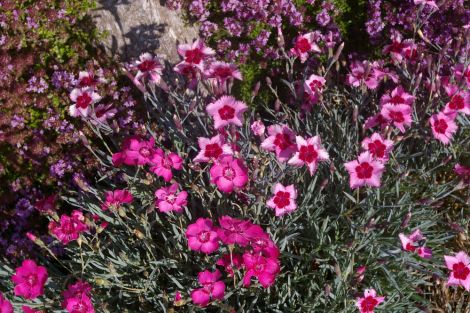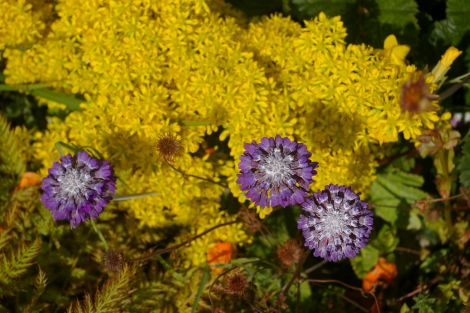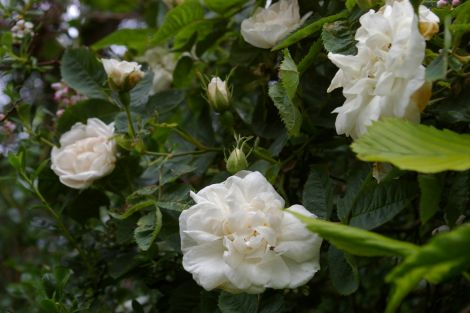Four Seasons / Four Seasons – Early Summer
There was something most shocking on the front page of the 1 July edition of The Shetland Times, and I don’t mean the missing apostrophe in the right hand top corner; I’m referring to the forest of strange antennae sprouting out of the head and shoulders of one of the medal-hung girls.
Was this some state-of-the-arts communication device? A drug-free electronic aid to help sweep up aquatic records (both are swimmers)? Wrong on both counts.
I’m not sure what this picture says about the photographer, and I won’t even mention the gardener responsible for the upkeep of this background shrubbery, but I don’t believe I’ve ever seen a Weigela florida ‘Variegata’ in a worse state of grooming.
July is the month to get out the secateurs and pruning saw, to be applied vigorously to shrubs that have done their flowering before midsummer or thereabouts. You can really go to town on the flowering currants now – if you haven’t done so already. Clip those that form a hedge to within an inch of their lives and remove all the old, tired, and spent wood of single specimens.
Brooms need a good going-over now and a sharp pair of sturdy scissors should be the tool of your choice. Cut back the soft, sappy growth they’ve managed to put on in 2011 by a third or more to keep them in shape and prevent them from growing leggy. Never, ever cut a broom back into its older wood – it rarely if ever survives the experience.
Once the deed is done and your early-flowering shrubs look like the self-conscious red-eared and red-faced victims of an over-zealous barber, do them a favour and mulch them with a generous amount of potash to help ripen their wood and prevent die-back during the coming winter.
Become a member of Shetland News
If you burn solid fuel, simply give them a thick top-dressing of ash – peat and/or wood only please. Coal ash contains toxins not conducive to plant growth, but can be used once thoroughly weathered – let’s say after a minimum of five years’ outdoor storage.Failing all that, you could apply a good handful of sulphate of potash to each individual tree and shrub.
The other day I came across the sad remains of a cabbage white butterfly in the pond – being devoured by the last remaining tadpoles on the waste-not-want-not principle. This year our brassicas are protected by an old herring net to excellent effect. They land on it, crawl around about for a bit then head off in search in more easily accessible members of the cabbage family.
At long last the vegetables are getting up a head of steam. Broad bean ‘The Sutton’ is starting to flower, the peas ‘Hurst Greenshaft’ have managed to twine their tendrils around their support and first early tatties ‘Duke of York’ have been earthed up and are on the point of flowering. The Chinese stir-fry greens have started to bolt and there is an abundance of lettuce – some also bolting.
Using the tadpoles’ principle, they’ll be turned into lettuce and hazelnut soup, a recipe given me by Bo Simmons of Burrastow. Thoroughly wash your lettuce, before throwing it into a cauldron of well-seasoned vegetable stock. Boil for exactly one minute, cool, blend, add as many or as few toasted, ground hazelnuts as you like, plus a good dollop of thick yoghurt before serving. This soup has a deceptively light taste, but is highly habit-forming.
In July beds and borders are overflowing with herbaceous treasures and the ornamental garden looks after itself – or so it seems. This is the time to keep a vigilant eye on weeds that work – unseen – behind the gardener’s back. Creeping buttercup, annual and perennial grasses, the dreaded bittercress and – one of our natives – Prunella vulgaris – manage to spread, flower and seed out of sight and out of mind – storing up massive problems for the years to come. Fetch the trowel and hoe, wade in there, and get the better of them.
Borders where all the individual components are matched perfectly according to vigour are a rare thing indeed. Last year I had a glorious stand of the wickedly dark, aubergine purple Campanula ‘Sarastro’. A season later, it is a shadow of its former self, all but elbowed out by its neighbours, magenta Geranium ‘Patricia’ to the south and a fire-red Asiatic lily to the north. Time to curtail them both.
Scent is an important element in the garden. Here, the clove-scented pinks are beginning their long summer season, and continue into autumn if the gardener finds time to do a little dead-heading. Dianthus x allwoodii ‘Alpinus’ is an old seed mix of rockery pinks that stands up well to the Shetland weather and, even more important, lasts in heavy, peaty soil. It’s outlived many a named cultivar, except the excellent Dianthus ‘Brympton Red’, which has been in my garden for over thirty years now.
Some of my old (as opposed to modern) roses have also clocked up three decades. Rosa alba maxima, also known as the Jacobite rose or the white rose of York, dates back to the 15th Century and can still be found in many old Shetland gardens. It grows into a vigorous shrub, over six feet tall and as wide if space permits, and is laden with double, quartered, scented white flowers for a good month every summer. It can be raised from cuttings taken in early autumn.
Floral premieres always raise the pulse, and this year Primula capitata, a Chinese species, has attracted much comment from Lea Gardens visitors, one of whom said: “I wish I had a brooch like that.”
Rosa Steppanova
Become a member of Shetland News
Shetland News is asking its readers to consider paying for membership to get additional perks:
- Removal of third-party ads;
- Bookmark posts to read later;
- Exclusive curated weekly newsletter;
- Hide membership messages;
- Comments open for discussion.
If you appreciate what we do and feel strongly about impartial local journalism, then please become a member of Shetland News by either making a single payment, or setting up a monthly, quarterly or yearly subscription.











